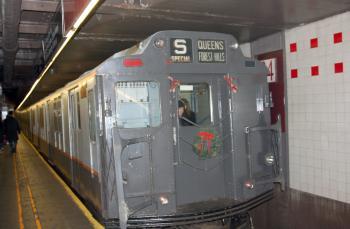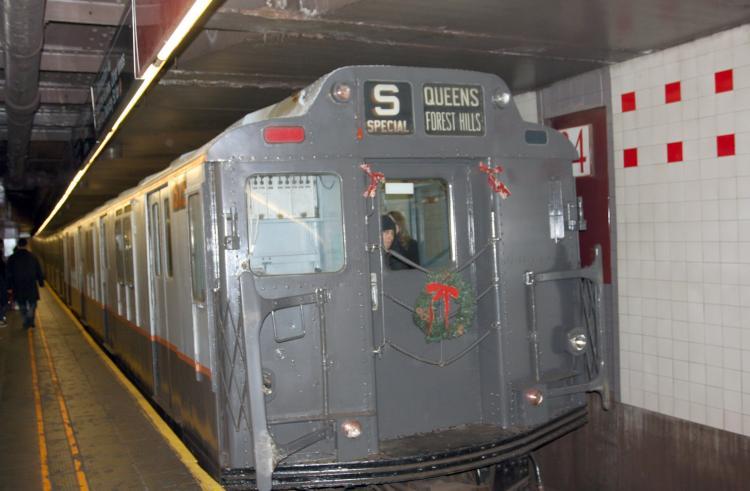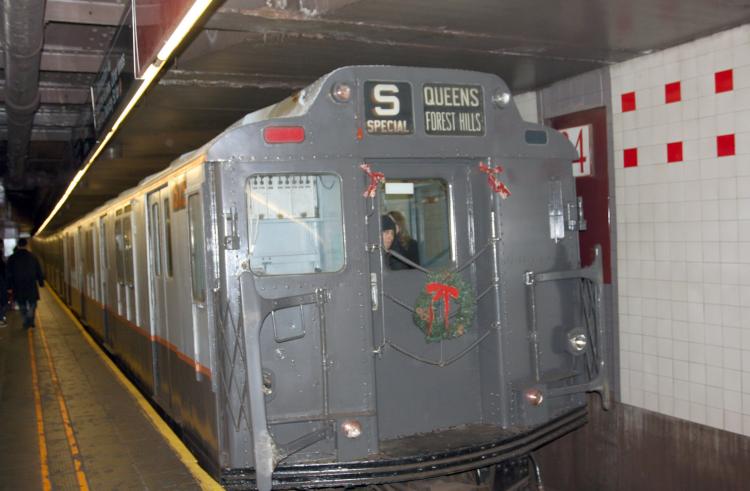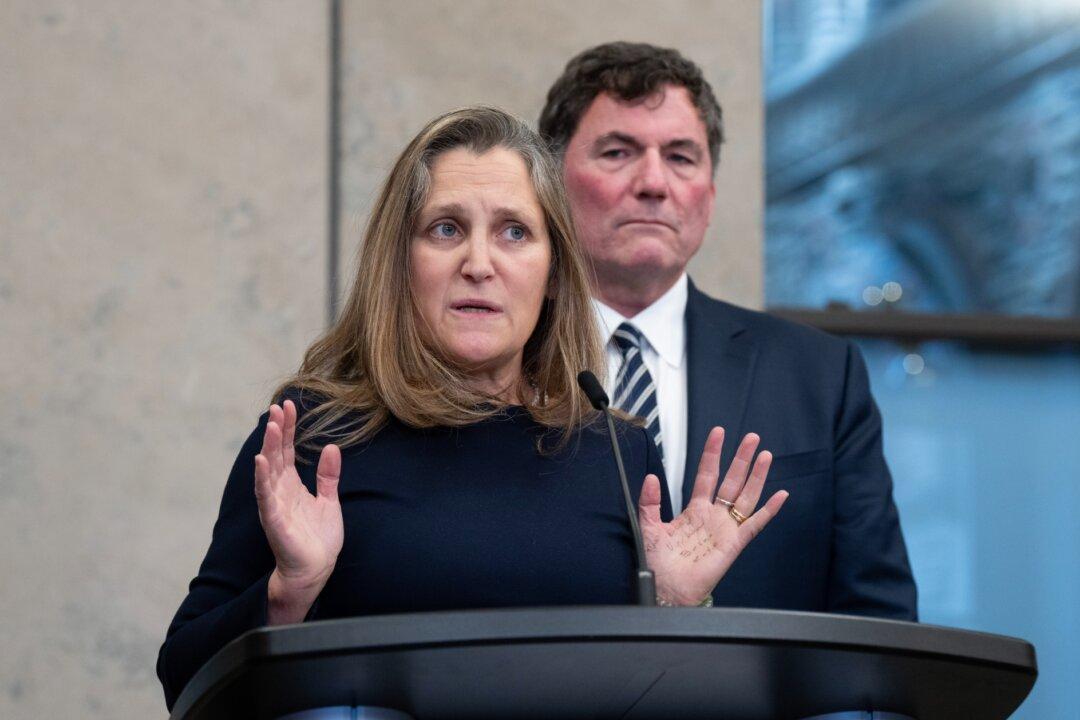NEW YORK—Sunday afternoon M-line riders stepped out of 2010 into the commuter’s life of yore. As a holiday treat, the MTA Transit Museum put its exhibit in motion, bringing out vintage trains and busses shortly after Thanksgiving. The old locomotives will return to the museum after a final run on Dec. 26.
In addition to the M-line train, which runs Sundays from 10 a.m. to 5 p.m., vintage busses are also rolling around town. The “nostalgia fleet” includes busses on lines throughout the five boroughs: B1 and B65 in Brooklyn, S61 in Staten Island, Q13 and Q46 in Queens, M34 and M42 in Manhattan, and Bx7 and Bx30 in the Bronx. The busses are anywhere from 40 to 60 years old.
The clanking and grinding of the approaching train was a hint to the riders on the platform that this trip would be a little different. Originally in production from the 1930s to the 1970s, the dark-green bulky steel cars clung through the subway tunnels from Manhattan to Queens once again.
The conductor’s head poked out between the cars, not enclosed in a compartment as today’s conductors are. With his feet on ledges to each side and the open track beneath, he pulled the levers to open the doors manually.
The workers and passengers alike were brought back to a time before so much could be accomplished with a simple push of a button.
The antique mechanism made a hissing sound as the doors opened, and riders took a trip back in time—back to a place in their memory for some, or to a time they never knew for others.
“This train used to run on my home line,” recalled Ralph Vega, an MTA conductor. He’s worked the rails for over 20 years but only knew these trains as a passenger.
“I’m here not only to work them, but [also] to remember,” said Vega.
He recalled the little things about the subway experience modern riders miss out on—like the damaged parts of the wicker seats poking their behinds. The seats were wicker, but the rest was steel.
As the cars shook back and forth, Vega commented: “These are hard-running, loud-running trains. The shocks are different, the whole makeup is different—it’s all steel.”
Ceiling fans cast shadows in the soft light shining forth from incandescent bulbs along each side of the car. Complete darkness would reign momentarily, as the lights flickered on and off.
The fluorescent lights of modern trains illuminate crisp images of models and slogans. The light was softer back then, and the advertisements were somehow softer too. Reproductions of old ads for soft drinks or Viceroy cigarettes feature illustrations and slogans more than photographs. Women were invited to buy Scotch-brand cellophane tape to breeze through their sewing projects with ease.
“Do you smell that?” asked Mike Rosenbluth of Brooklyn.
The old trains have a particular scent—maybe it is the way they grind on the tracks, he suggested. The train brings Rosenbluth back to days long gone.
“It can bring me back to grandma’s house,” said Rosenbluth. “But grandma isn’t there anymore.”
It’s not the smooth ride of our modern alloys and mechanisms, nor is it a quiet one—but these relics have the power to delight today’s passengers.
“This is what train conversations used to be like!” yelled Rosenbluth’s friend Andrew McKeon with a smile on his face.
“I’ve heard lots of ‘ohs’ and ’ahs’ and ‘wows,’” said Vega. “The reactions are great excitement.”
This won’t be the last chance to enjoy this slice of history. The trains and buses come out now and then, for the holidays or for other special occasions, said Vega. One can also see the “nostalgia fleet” at the MTA Transit Museum.
In addition to the M-line train, which runs Sundays from 10 a.m. to 5 p.m., vintage busses are also rolling around town. The “nostalgia fleet” includes busses on lines throughout the five boroughs: B1 and B65 in Brooklyn, S61 in Staten Island, Q13 and Q46 in Queens, M34 and M42 in Manhattan, and Bx7 and Bx30 in the Bronx. The busses are anywhere from 40 to 60 years old.
The clanking and grinding of the approaching train was a hint to the riders on the platform that this trip would be a little different. Originally in production from the 1930s to the 1970s, the dark-green bulky steel cars clung through the subway tunnels from Manhattan to Queens once again.
The conductor’s head poked out between the cars, not enclosed in a compartment as today’s conductors are. With his feet on ledges to each side and the open track beneath, he pulled the levers to open the doors manually.
The workers and passengers alike were brought back to a time before so much could be accomplished with a simple push of a button.
The antique mechanism made a hissing sound as the doors opened, and riders took a trip back in time—back to a place in their memory for some, or to a time they never knew for others.
“This train used to run on my home line,” recalled Ralph Vega, an MTA conductor. He’s worked the rails for over 20 years but only knew these trains as a passenger.
“I’m here not only to work them, but [also] to remember,” said Vega.
He recalled the little things about the subway experience modern riders miss out on—like the damaged parts of the wicker seats poking their behinds. The seats were wicker, but the rest was steel.
As the cars shook back and forth, Vega commented: “These are hard-running, loud-running trains. The shocks are different, the whole makeup is different—it’s all steel.”
Ceiling fans cast shadows in the soft light shining forth from incandescent bulbs along each side of the car. Complete darkness would reign momentarily, as the lights flickered on and off.
The fluorescent lights of modern trains illuminate crisp images of models and slogans. The light was softer back then, and the advertisements were somehow softer too. Reproductions of old ads for soft drinks or Viceroy cigarettes feature illustrations and slogans more than photographs. Women were invited to buy Scotch-brand cellophane tape to breeze through their sewing projects with ease.
“Do you smell that?” asked Mike Rosenbluth of Brooklyn.
The old trains have a particular scent—maybe it is the way they grind on the tracks, he suggested. The train brings Rosenbluth back to days long gone.
“It can bring me back to grandma’s house,” said Rosenbluth. “But grandma isn’t there anymore.”
It’s not the smooth ride of our modern alloys and mechanisms, nor is it a quiet one—but these relics have the power to delight today’s passengers.
“This is what train conversations used to be like!” yelled Rosenbluth’s friend Andrew McKeon with a smile on his face.
“I’ve heard lots of ‘ohs’ and ’ahs’ and ‘wows,’” said Vega. “The reactions are great excitement.”
This won’t be the last chance to enjoy this slice of history. The trains and buses come out now and then, for the holidays or for other special occasions, said Vega. One can also see the “nostalgia fleet” at the MTA Transit Museum.







